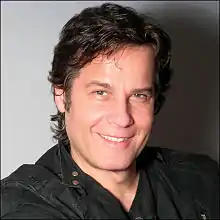Harlan J. Brothers
Harlan J. Brothers is an inventor, composer, mathematician, and educator based in Branford, Connecticut.
Harlan J. Brothers | |
|---|---|
 Harlan J. Brothers in 2012 | |
| Nationality | American |
| Alma mater | Berklee College of Music Gateway Community College |
| Scientific career | |
| Fields | Inventing, Mathematics, Music, Education |
Life and work
In 1997, while examining the sequence of counting numbers raised to their own power ( {an}=nn ), Brothers discovered some simple algebraic formulas [1] that yielded the number 2.71828..., the universal constant e, also known as the base of the natural logarithm. Like its more famous cousin π, e is a transcendental number that appears in a wide range of formulas in mathematics and physics.
Having no formal college-level mathematics education, he sent brief descriptions of his findings to the host of the National Public Radio show "Science Friday" and also to a well-known mathematician at Scientific American.[2]
His communication with "Science Friday" led to a fruitful collaboration with meteorologist John Knox. Together they discovered over two dozen new formulas and published two papers on their methods. These methods subsequently found their way into the standard college calculus curriculum by way of two popular textbooks on the subject.[3][4]
Brothers went back to school to study calculus and differential equations. He went on to publish methods for deriving infinite series that include the fastest known formulas for approximating e.[5]
In the summer of 2001, his professor, Miguel Garcia, introduced him to Benoît Mandelbrot and Michael Frame at Yale University. Brothers soon began working with them to incorporate the study of fractals into core mathematics curricula. His current research, begun in collaboration with Frame, is in the field of fractals and music.[6]
See also
Publications
- 1998. "New closed-form approximations to the Logarithmic Constant e.” With J. A. Knox. In: The Mathematical Intelligencer, Vol. 20, No. 4, 1998; pages 25–29.
- 1999. "Novel series-based approximations to e.” With J. A. Knox. In: The College Mathematics Journal, Vol. 30, No. 4, 1999; pages 269–275.
- 2004. "Improving the convergence of Newton's series approximation for e.” The College Mathematics Journal, Vol. 35, No. 1, 2004; pages 34–39.
- 2007. "Structural Scaling in Bach’s Cello Suite No. 3.” Fractals, Vol. 15, No. 1, 2007; pages 89–95.
- 2008. "How to design your own pi to e converter." The AMATYC Review, Vol. 30, No. 1, 2008; pages 29–35.
- 2009. "Intervallic scaling in the Bach cello suites." Fractals, Vol. 17, No. 4, 2009; pages 537–545.
- 2010. "Mandel-Bach Journey: A marriage of musical and visual fractals." Proceedings of Bridges Pecs, 2010; pages 475–478.
- 2012. "Finding e in Pascal’s Triangle." Mathematics Magazine, Vol. 85 No. 1, 2012; page 51.
- 2012. "Pascal's Triangle: The Hidden Stor-e." The Mathematical Gazette, Vol. 96, No. 535, 2012; pages 145–148.
- 2012. "Pascal's Prism." The Mathematical Gazette, Vol. 96, No. 536, 2012; pages 213–220.
- 2012. "Glimpses of Benoît Mandelbrot (1924-2010).” With M. F. Barnsley, M. Berry, M. Frame, I. Stewart, D. Mumford, K. Falconer, R. Eglash, N. Lesmoir-Gordon, J. Barrallo. In: Notices of the American Mathematical Society, Vol. 59, No. 8, 2012; pages 1056–1063.
- 2015. "Benoit Mandelbrot: Educator." With N. Neger. In: Benoit Mandelbrot - A Life in Many Dimensions, World Scientific Publishing, edited by Michael Frame (spring, 2015). ISBN 978-9814366069
- 2015. "The Nature of Fractal Music." In: Benoit Mandelbrot - A Life in Many Dimensions, World Scientific Publishing, edited by Michael Frame (spring, 2015). ISBN 978-9814366069
References
- H. J. Brothers and J. A. Knox, "New closed-form approximations to the Logarithmic Constant e.” The Mathematical Intelligencer, Vol. 20, No. 4, 1998; pages 25-29.
- Willson, Daniel (Fall 1999). "To "e" or Not To "e"? That's a Constant Question". UAB Magazine. Vol. 19 no. 3. Archived from the original on 2012-02-08.
- R. Larson, B. Edwards, and R. Hostetler, Calculus With Analytic Geometry, Seventh Edition. Houghton Mifflin Company, 2002.
- R. Larson and B. Edwards, Calculus: Early Transcendental Functions, Fifth Edition. Houghton Mifflin Company, 2010.
- H. J. Brothers, "Improving the convergence of Newton's series approximation for e.” The College Mathematics Journal, Vol. 35, No. 1, 2004; pages 34-39.
- Fractal Music Workshops, Brothers Technology website
Further reading
- Ivars Peterson. "A Fractal in Bach's Cello Suite," Mathematical Association of America, 2008.
- Forrest Mimms. "Harlan J. Brothers in the Spotlight," The Citizen Scientist, 2007.
- Clifford A. Pickover. "The Möbius Strip," page 195. Thunder's Mouth Press, New York, 2006.
- Clifford A. Pickover. "A Passion for Mathematics," page 76. Wiley, New Jersey, 2005.
- Ivars Peterson. "Hunting e," Science News, 2004.
- Clifford A. Pickover. "Wonders of Numbers," page 4. Oxford University Press, New York, 2001.
- John Knox (meteorologist). "Serendipit-e," NASA Goddard Institute for Space Studies, 1998.
External links
- Harlan Brothers: CV
- Brothers Technology Home Page
- Mandelbrot zoom animation from the music documentary Bach & friends
- The Sounds of Pi: A Unique Musical Interpretation
- Fractal Geometry at Yale: Panorama of Uses (Michael Frame)
- The Bach Project (Michael Lawrence)
- YouTube interview on Bach and fractals (Michael Lawrence)
- OEIS sequence A178819 (Pascal's prism (3-dimensional array) read by folded antidiagonal crossections)
- OEIS Profile